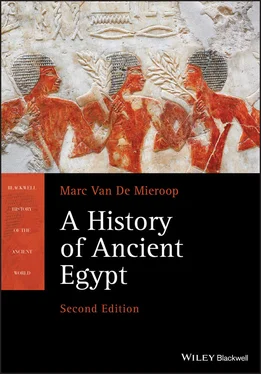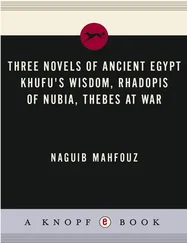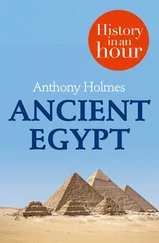1 Cover
2 Title Page
3 Copyright Page
4 List of Illustrations
5 Maps
6 Preface to the Second Edition
7 1 Introductory Concerns 1.1 What is Ancient Egypt? 1.2 Egypt’s Geography 1.3 The Makeup of Egyptian Historical Sources 1.4 The Egyptians and Their Past 1.5 The Chronology of Egyptian History 1.6 Prehistoric Developments
8 2 The Formation of the Egyptian State (ca. 3400–2686) 2.1 Sources 2.2 Royal Cemeteries and Cities 2.3 The First Kings 2.4 Ideological Foundations of the New State 2.5 The Invention of Writing 2.6 Foreign Relations
9 3 The Great Pyramid Builders (ca. 2686–2345) 3.1 Sources 3.2 The Evolution of the Mortuary Complex 3.3 Administrating the Old Kingdom State 3.4 Ideological Debates? 3.5 Foreign Relations 3.6 Later Traditions about the Old Kingdom
10 4 The End of the Old Kingdom and the First Intermediate Period (ca. 2345–2055) 4.1 Sources 4.2 The Rise of the Regions and Political Fragmentation 4.3 Foreign Relations 4.4 Competition between Herakleopolis and Thebes 4.5 Appraising the First Intermediate Period
11 5 The Middle Kingdom (ca. 2055–1650) 5.1 Sources and Chronology 5.2 Kings and Regional Elites 5.3 Kings as Warriors 5.4 Egypt in the Wider World 5.5 The Cult of Osiris 5.6 Middle Kingdom Literature and its Impact on Egyptian Culture
12 6 The Second Intermediate Period and the Hyksos (ca. 1700–1550) 6.1 Sources and Chronology 6.2 Avaris: Multiple Transformations of a Delta Harbor 6.3 The Hyksos 6.4 Nubia and the Kingdom of Kush 6.5 Thebes in the Middle 6.6 The Hyksos in Later Perspective
13 7 The Birth of Empire: The Early 18th Dynasty (ca. 1550–1390) 7.1 Egypt in a New World Order 7.2 Sources and Chronology 7.3 Egypt at War 7.4 Egypt and the Outside World 7.5 Domestic Issues
14 8 The Amarna Revolution and the Late 18th Dynasty (ca. 1390–1295) 8.1 An International Age 8.2 Amenhotep III: The Sun King 8.3 From Amenhotep III to Amenhotep IV/Akhenaten 8.4 Akhenaten 8.5 Akhenaten’s Memory
15 9 The Ramessid Empire (ca. 1295–1213) 9.1 Domestic Policy: Restoration and Renewal 9.2 International Relations: Reforming the Empire 9.3 Rameses’s Court 9.4 A Community of Tomb Builders
16 10 The End of Empire (ca. 1213–1070) 10.1 Problems at Court 10.2 Breakdown of Order 10.3 The Decline of Royal Power 10.4 Pressures from Abroad 10.5 End of the New Kingdom
17 11 The Third Intermediate Period (ca. 1069–715) 11.1 Sources and Chronology 11.2 Twin Cities: Tanis and Thebes (the 21st dynasty, 1069–945) 11.3 Libyan Rule (22nd to 24th dynasties, 945–715) 11.4 The End of the Third Intermediate Period
18 12 Egypt in the Age of Empires (ca. 715–332) 12.1 Sources and Chronology 12.2 The Eastern Mediterranean in the 1st Millennium 12.3 Egypt, Kush, and Assyria (ca. 715–656) 12.4 Egypt, Greeks, and Babylonians (656–525) 12.5 Recollections of the Past Under the Kings of Kush and Sais 12.6 Egypt and Persia (525–332)
19 13 Greek and Roman Egypt (332 BC–AD 395) 13.1 Sources and Chronology 13.2 Alexandria and Philae 13.3 Kings, Queens, and Emperors 13.4 Greeks, Romans, and Egyptians 13.5 Economic Developments: Agriculture, Finance, and Trade 13.6 The African Hinterland 13.7 The Christianization of Egypt
20 Epilogue
21 Guide to Further Reading Chapter 1: Introductory Concerns Chapter 2: The Formation of the Egyptian State (ca. 3400–2686) Chapter 3: The Great Pyramid Builders (ca. 2686–2345) Chapter 4: The End of the Old Kingdom and the First Intermediate Period (ca. 2345–2055) Chapter 5: The Middle Kingdom (ca. 2055–1650) Chapter 6: The Second Intermediate Period and the Hyksos (ca. 1700–1550) Chapter 7: The Birth of Empire: The Early 18th Dynasty (ca. 1550–1390) Chapter 8: The Amarna Revolution and the Late 18th Dynasty (ca. 1390–1295) Chapter 9: The Ramessid Empire (ca. 1295–1213) Chapter 10: The End of Empire (ca. 1213–1070) Chapter 11: The Third Intermediate Period (ca. 1069–715) Chapter 12: Egypt in the Age of Empires (ca. 715–332) Chapter 13: Greek and Roman Egypt (332 BC–AD 395) Epilogue
22 Glossary
23 King List
24 Bibliography
25 Index
26 End User License Agreement
1 Chapter 4 Table 4.1Dynasties of the First Intermediate Period
2 Chapter 6 Table 6.1Dynasties of the Second Intermediate Period
1 Chapter 1 Figure 1.1 Egyptian archetypes. This pair of painted limestone statues, 120 ... Figure 1.2 Nubian archetype. On this 10‐cm‐high limestone trial piece for a ... Figure 1.3 Syrian archetype. This 13‐cm‐high glazed tile, originally used as... Figure 1.4 A matter of presentation. In the 14th century, images of the Nubi... Figure 1.5 Before the building of the Aswan dams the height of the Nile Rive... Figure 1.6 As papyrus was expensive, potshards and flakes of limestone provi... Figure 1.7 This image shows a detail of a fragmentary king list carved on a ... Figure 1.8 A 25‐cm‐high ceremonial mace head carved in limestone depicts a k...
2 Chapter 2 Map 1 Egypt and Nubia from prehistory to the Middle Kingdom Figure 2.1 One of the most widespread emblems of kingship in ancient Egypt r... Figure 2.2 In a tomb of the Late Naqada period at Abydos, called U‐j by its ... Figure 2.3 The monumental Palette of King Narmer (front and back shown here)... Figure 2.4 One of the earliest statues in the round of a king of Egypt is th... Figure 2.5 Excavations at Coptos revealed three statues dated around 3300 of... Figure 2.6 On this label of ebony wood, 8 by 5.5 cm, the upper right panel s... Figure 2.7 Hieratic script was a rapid form of hieroglyphic initially used f... Figure 2.8 In the first few centuries ad Coptic script was developed to writ...
3 Chapter 3 Map 2 Pyramid locations Figure 3.1 Sneferu’s pyramid at Meidum represents one of the earliest attemp... Figure 3.2 Plan of Giza plateau. While the great pyramids dominate with thei... Figure 3.3 Abusir papyrus. British Museum, London, EA10735,10 H 20.5 cm.Figure 3.4 This wooden panel, 115 cm high, is one of six found at Saqqara in...Figure 3.5 In the valley temple of King Menkaura’s pyramid at Giza were exca...Figure 3.6 This sculpture of Khafra, carved from diorite stone from the sout...Figure 3.7 In the mortuary temple of Sahura at Abusir appear reliefs carved ...
4 Chapter 4Figure 4.1 With the decentralization of power in the First Intermediate Peri...Figure 4.2 The pyramid at Saqqara of the last ruler of the 5th dynasty, King...Figure 4.3 Starting in First Intermediate Period, non‐royals had mortuary te...Figure 4.4 Because Pepy II became king as a young boy, his mother acted init...Figure 4.5 This very nicely carved hieroglyphic text, on limestone (the segm...Figure 4.6 This limestone stele, which measures 37 by 45 cm and is said to h...Figure 4.7 With the creation of a new dynasty in Thebes, artists there start...
5 Chapter 5Figure 5.1 This 46‐cm‐high statue carved from graywacke stone shows the head...Figure 5.2 In the Middle Kingdom, provincial governors were able to pass the...Figure 5.3 Senusret I started the development of the Amun temple at Karnak i...Figure 5.4 The find of a collection of letters and accounts belonging to a p...Figure 5.5 This 18‐cm‐high wooden statuette is an execration figurine, that ...Figure 5.6 Middle Kingdom Egypt constructed multiple fortresses along the 2n...FIGURE 5.7 This stele was set up in Abydos by the brother of Rehuerdjersen, ...
6 Chapter 6Figure 6.1 This 55‐cm‐high limestone funerary stele was made for an official...Figure 6.2 Detail of the Rhind mathematical papyrus. British Museum, London ...Figure 6.3 This 7.8‐cm‐high double vase onto which the images of lotus flowe...Figure 6.4 This 11‐cm‐high ceramic beaker is typical for the archaeological ...Figure 6.5 The rulers of Kerma during the Classical Kerma phase had themselv...Figure 6.6 Since the Kerma state at the time of the Second Intermediate Peri...
Читать дальше












